Apple's 2010 MacBook Air (11 & 13 inch) Thoroughly Reviewed
by Anand Lal Shimpi on October 26, 2010 10:08 PM EST- Posted in
- Mac
- Apple
- MacBook Air
- Laptops
The 11-inch MacBook Air: Faster than the old 13-inch MacBook Air
On paper, the new 13-inch MacBook Air shouldn’t be any faster than the old 2008 MacBook Air - at least in CPU bound tasks. The 2010 model gets a faster GPU but the CPU is literally the same 1.86GHz Core 2 Duo. Memory sizes and speeds haven’t changed either. While the SSD is faster, if you’re running a CPU bound benchmark there shouldn’t be any performance difference. If you assumed the same thing I did, you’d be very wrong.
Take a look at Cinebench 11 comparing the 2008 13-inch MacBook Air to the two 2010 models:
| Cinebench 11 - Multithreaded CPU Benchmark | |||||
| 11-inch MacBook Air (2010) - 1.4GHz Core 2 Duo | 13-inch MacBook Air (2010) - 1.86GHz Core 2 Duo | 13-inch MacBook Air (2008) - 1.86GHz Core 2 Duo | |||
| Cinebench 11 Score (Higher is Better) | 0.81 | 1.1 | 0.70 | ||
Not only is the 2008 13-inch MBA slower than the new 13-inch model, it’s actually slower than the 11-inch model running at 1.4GHz. Something is amiss. Perhaps it’s just this benchmark?
I turned to our Handbrake H.264 encode test to verify my sanity:
| Handbrake 0.94 - H.264 High Profile Transcode | |||||
| 11-inch MacBook Air (2010) - 1.4GHz Core 2 Duo | 13-inch MacBook Air (2010) - 1.86GHz Core 2 Duo | 13-inch MacBook Air (2008) - 1.86GHz Core 2 Duo | |||
| Average Frames per Second (Higher is Better) | 1.14 fps | 1.55 fps | 0.96 fps | ||
Once again, a similar situation. The old MBA is actually slower than the new 11-inch, despite the advantage in CPU speed.
It looks like what we’ve stumbled upon is a combination of Apple aggressively throttling the clock speed of the older MacBook Air CPUs to meet thermal requirements, and the CPUs used in the new MacBook Airs being far better behaved from a voltage/power consumption standpoint.
The 45nm process these Core 2s are built on is as mature as it’s going to get. I’m guessing yield on these parts is as high as can be and as a result, power consumption is probably consistently lower than the original 1.86GHz parts Apple shipped back in 2008. The peak thermal specs themselves haven’t changed, but the actual power characteristics have.
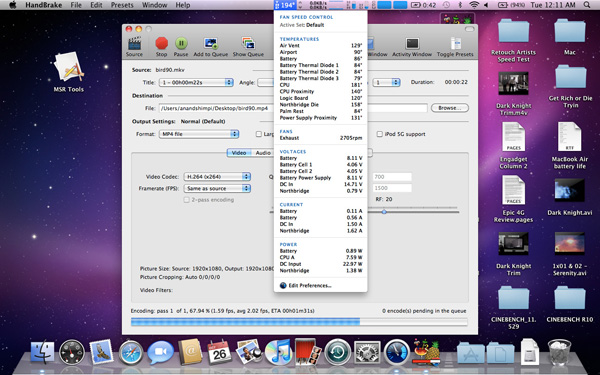
The 2008 MacBook Air under Load
Maximum temperature, at least reported by the MBA’s sensors, isn’t any lower on the new 13-inch than the 2008 I compared it to. Both CPUs hit roughly 84C (183F) under full load. But look at what happens to the chips after a minute at that load:
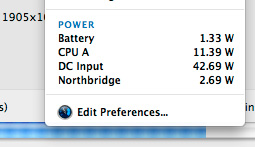 2010 13-inch MacBook Air |
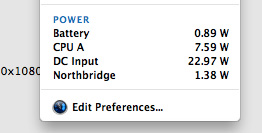 2008 13-inch MacBook Air |
iStat Menus reports the 1.86GHz Core 2 Duo in the 2008 system consuming only 7.59W, while the same CPU in the 2010 machine is drawing 11.45W. The 2008 machine is throttling back to reduce overall temperature while the 2010 system keeps going.
As a result, even the 11-inch MacBook Air will probably end up being as fast, if not faster than the 2nd generation 2008 13-inch MacBook Air. And our performance results confirm that:
| 11-inch MacBook Air (2010) vs. 13-inch MacBook Air (2008) | ||||||||
| Application Launch Test | Adobe Photoshop CS4 | Aperture RAW Import | Cinebench R10 - 1CPU | Cinebench R10 - XCPU | Quicktime H.264 Transcode | |||
| Apple 11-inch MacBook Air (2010) - 1.4GHz Core 2 Duo | 27.8 seconds | 72.4 seconds | 1.29 PPS | 1612 | 2967 | 33.1 fps | ||
| Apple 13-inch MacBook Air (2008) - 1.86GHz Core 2 Duo | 26.4 seconds | 71.3 seconds | 1.20 PPS | 2046 | 2882 | 30.1 fps | ||
You'll notice the less CPU intensive tasks are quicker on the old 13-inch system as the CPU isn't able to get hot enough to trigger Apple's throttling. The single threaded Cinebench test is the best example of this. The 26% performance advantage jibes with the 33% increase in CPU clock speed (it's actually a little low, most likely because the old CPU still isn't running at full speed even in this test). But now look at the heavier tests - the multithreaded Cinebench test and the Quicktime encode. Both of these stress both cores and drive TDP up, which forces Apple to pull clock speed back down. We wondered how Apple was able to cram such a high speed CPU into such a thin chassis as early as it did, now we know.
In practice I found the 2008 13-inch MBA launched applications quicker (short bursts of full clock speed), but after prolonged use or completing CPU intensive tasks it was tough to tell apart from the new 11-inch. What's even more troublesome is that Apple's aggressive clock throttling went relatively undetected until now. This is something I'm going to have to devise tests for and pay more attention to in future reviews. Sneaky, Steve, sneaky.
External Temperatures and Noise
The old MacBook Air chassis had a few dozen slits cut out of the aluminum for ventilation. The new MacBook Air chassis hides the ventilation slits between the base of the unit and the hinge. You can’t see them, but they’re there.
The slits are smaller than they were on the old chassis, which means moving air through them at the same rate sounds louder than before.
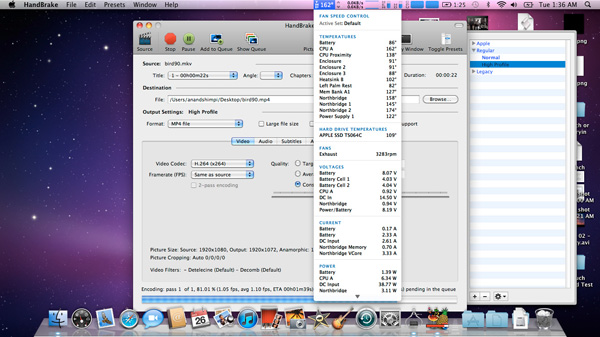
The 11-inch MacBook Air under Load
The CPU in the 11-inch model, even when under heavy loads, likes to stay at or below 72C (162F). At that temperature, the internal fan doesn’t spin above 4000 RPM (usually down below 3400). The 13-inch MacBook Air however is far more likely to generate noise. Running our simple Handbrake test the CPU will peak at over 82C (~180F) and the system’s internal fan will ramp up to over 6K RPM to compensate. Not only does the chassis get hot, but the fan gets audible. It’s still too small of a fan to really be considered loud in the grand scheme of things, but it’s loud enough to be annoying.
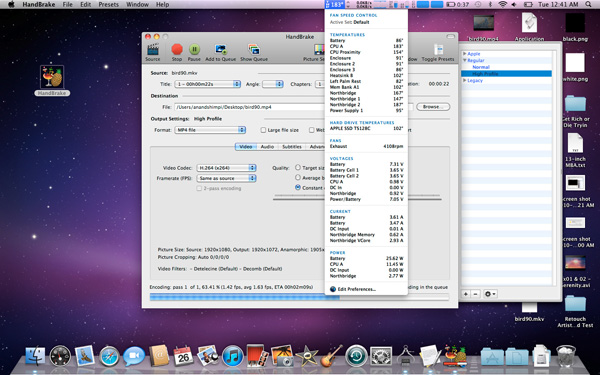
The 13-inch Macbook Air under Load
The surface temperature of the new 13-inch MacBook Air easily gets as high as the 2008 model. I measured a peak of 38.9C (102F) on both the 2008 and 2010 13-inch models. The 11-inch never broke 38C (100F).
Even casual use can ramp up temperatures pretty quickly. Just having a few websites open in the background that use Flash or other CPU intensive elements can slowly cause the MBA’s internal temperatures to rise. And now you’re beginning to see why Apple doesn’t install Flash on these things by default.
The danger zone is the upper left corner of the system, near the hinge. There’s only a single fan that cools both the CPU and GPU in the Air’s very tight enclosure. This is where that fan sits.










185 Comments
View All Comments
nvidia2008 - Wednesday, October 27, 2010 - link
Great article, just one niggle, Instant On does not refer to Boot, nor Wake From Sleep.From the Apple website:
"And when you put MacBook Air to sleep for more than an hour, it enters what’s called standby mode. So you can come back to MacBook Air a day, a week - even up to an entire month later - and it wakes in an instant."
http://www.apple.com/macbookair/design.html
Instant On refers to a Standby Mode (basically hibernate) that is not Boot nor Wake From Sleep.
AMDJunkie - Wednesday, October 27, 2010 - link
This is a good point; Macs with hard drives have "deep sleep" standby, which is the typical, "Hey, your battery is about to die so we're taking the system state from RAM to the hard drive" hibernation. This is an SSD, though, so I presume it writes it to the SSD after an hour, instead of after your battery dips under 5%, to help you save battery.nvidia2008 - Wednesday, October 27, 2010 - link
Yeah, I think Deep Sleep is the most closely related thing to Instant On, not Boot or Wake From Sleep. Cheershechacker1 - Wednesday, October 27, 2010 - link
OS-X, when put to sleep by closing the lid, will write out the necessary parts of memory to the hard drive.Then if your battery dies, the hibernate state resumes when you plug it back in.
If you have a ton of applications open and are using a lot of ram before closing the lid, it does take noticeably longer to actually begin sleep and turn off the HD, as indicated by the light on the macbook.
tipoo - Wednesday, October 27, 2010 - link
Yeah, Instant On is really just fast-wake-from-hibernate.Tuntavern - Wednesday, October 27, 2010 - link
Now there ARE two.ginny - Wednesday, October 27, 2010 - link
HiYou had said that your macbook air was using about 1.4 gb of memory when diting a handful of imgs in Photoshop. Do you think then that it isnt the best machine to get if I anticipate in using Adobe CS frequently? Do you think i should opt for a MBP instead? Or will upgrading the CPU and Memory suffice?
Thanks!
zhill - Wednesday, October 27, 2010 - link
Good review. I was waiting for you guys to review the new airs, good data. FYI, your images comparing the 13" MBA's size appear to be labeled incorrectly. I think the image (http://images.anandtech.com/reviews/mac/macbookair... is comparing the MBA 13" to the MBP 15" rather than the MBP 13".I'm also surprised that the screens had such a limited color gamut, I expected something in the 70% range rather than 40% but I suppose they trade that for energy efficiency(?).
I would be very curious to see your benchmarks include a new air with the 2.13GHz C2D and 4GB RAM to compare that to the the 1.86Ghz. I seem to recall that the last generation 2.13Ghz Air had even more thermal throttling issues than the lower spec chip so I wonder if it has been addressed in that configuration as well.
Any ideas on how they achieved such a fast wake time compared with the MBP 15" w/SSD? Typically, a sleep/wake operation is not very dependent upon the disk as the memory is kept powered so the system state should easily be restored without much disk access. Interesting stuff.
dsee15 - Wednesday, October 27, 2010 - link
Great Review, thank you!How much faster do you think the 13 MBA with 2.1Ghz proc, 4GB Mem, 256GB SSD would be over the stock model you tested? Do you think the faster proc will generate too much heat and initiate the governor?
How would this 'tricked out' system run VMware/windows/office?
Lastly, it appears the tricked out version could out perform both the 13 MB aluminum with hard drive and 13 MBP with hard dive, except for the most cpu intensive apps, agree...??? Could it replace a 15 MBP with hard drive?
doubledown21 - Wednesday, October 27, 2010 - link
Will there be any updates to the benchmarks if/when the 2.13GHz MBA is tested?